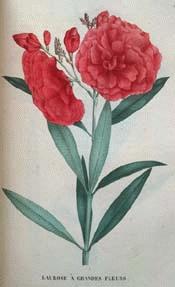
Botanical.com Home Page
OleanderEditors note:The text version of A Modern Herbal incorrectly references Oleander to Periwinkle. The following addition is not part of the the original version of A Modern Herbal. Botanical: Nerium oleander---Synonyms---Oleander, Rose Bay, Rose Bay Tree
An evergreen ornamental shrub to 12 feet high and as wide with white, pink or red flowers in spring and summer. The leaves resemble olive and bay trees. The flowers have five petals and resemble a tiny rose. It thrives in hot, mild climates and tolerates considerable drought, poor drainage and high salt content in the soil. Since deer will not eat this plant and it is so tolerant of a variety of poor soils, it is commonly used as a decorative freeway median in California and other mild-winter states in the USA. All parts of the plant are poisonous to humans and other animals. Children should be cautioned against eating the leaves and flowers. Prunings and dead leaves should be kept away from hay or other animal feed. The wood should not be used for barbecue fires or skewers. The smoke can cause severe irritation.
© Copyright Protected 1995-2025 Botanical.com
|
